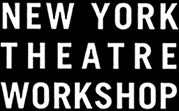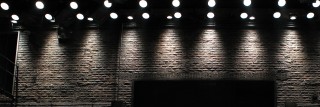

Before wrapping up her time as the 2050 Development Fellow for the 2022/23 Season, Phoebe Moore made it her mission to sit down with Jeffrey Wallach, NYTW Costume Shop and Wardrobe Manager.
September 2023 marks the 17th year Jeffrey has been a member of the Workshop’s staff! We want to take a moment to “throw the confetti,” as our vivacious Artistic Director Patricia likes to say, and help you get to know the incomparable human who works hard to help artists tell their stories through what they wear on our stages.
Join me on a figurative journey across the street from the theatre to the fabulous costume shop. You’re surrounded by racks of costumes from years past. Floor to ceiling shelves are filled with organized boxes containing every possible sewing notion and costume item you can imagine. You pull up a chair at one of the workstations and settle in for a brief but truly rich introduction to a legend—our words, not his!
Phoebe Moore: My first question is what inspires you? Very broad question.
Jeffrey Wallach: It is very broad, and It depends on what you mean by inspires me; personally or theatrically. For instance, when Linda Cho [Costume Designer, The Half-God of Rainfall] comes in with a wonderful rendering, I am inspired to get going and make those costumes. Not every designer comes through with a wonderful rendering, let’s be honest.
Some people come in with no knowledge of what they’re doing until we get to tech when they start to style the show, which is a very different form of design. That is not inspiring. In fact, it’s uninspiring. For me, maybe I’ll see a flower. Maybe I’ll see a painting in a museum. Maybe I’ll taste some food and I’ll go, “Oooh, this reminds me of…” That can be an inspiration to create art.
Phoebe: I love that. What is your first memory of going to the theater? Or how did you fall in love with theater or the performing arts?
Jeffrey: Well, my mother and the doctor that delivered me both said that the first smack sounded like applause, so I started performing, right out the womb. I thought I was going to be a performer! I tried it in grammar and middle school but found it was not for me. I like to perform and still do, however my strength is in support and organization.
The first show that I can remember…Now this is tough because I know that when I was very young, I remember that my grandmother made a big deal about us going to go see the movie Pinocchio, which was in its first re-release. No, and I did not see it in the forties when it originally came out. I saw it in the in about 1962 or 63 when I was little. I remember we had to get dressed up and put on a jacket and a tie and long pants to go to the theatre to see the movie in a cinema.
I also remember my parents taking me on Saturdays or Sundays to the local high school. We saw a traveling theater company (“The Story Book Players”? I’m making up a name. I don’t remember exactly who they were.) that was a subscription, you went every weekend. I it was Cinderella or something like that. The one thing that absolutely I remember is, while watching the show, when they started to do the set change, the actress playing, maybe The Stepsister, grabbed all the dishes off the table before the other sister grab the table and ran the other way. They looked like they bumped into each other and I shouted, “Oh my goodness! Watch out!” And because I was ‘in the moment’ of watching the two of them, they broke up laughing. I didn’t understand, that I actually broke their characters. Not at all intentional. But that imbedded the magic of live theatre within me. Truly, audience participation and reaction are what make theatre ‘live’.
It was very exciting to be watching this live thing happen. It wasn’t a television show. It wasn’t a movie. I remember the next weeks’ show was an argument between The Sun and The Wind, as to “who was more powerful?” They were sitting on a set of monkey bars on the stage. The Sun showed how powerful he was and the 3rd actor playing The Man put his hat on to shade himself. Then The Wind showed how powerful he was – he blew the Man’s hat off. Watching these happen on stage are my first memories.
Now do I remember seeing Pearl Bailey in Hello, Dolly! 1968, my 11th birthday present. Oh yes. Do I remember seeing the original Mame, with the replacement star Ann Miller, yes. Maybe my 12th Birthday present? That was many, many years ago before many of you were even considered.
Phoebe: Alright, so in your experience so far, how have you seen the industry shift when it comes to creating and maintaining costumes for productions, props, etc?
Jeffrey: The whole world of theater is, I don’t want to say barreling, it’s more like rocketing – it’s on a rocket projection – going forward. We have so many new fabrics, chemicals and techniques. Originally, you used to take Papier Mache to make a crown, and then it became a little bit more exciting because you could use Plaster of Paris. Which turned into fiberglass which turned into vacuum form and today, there’s Fosshape and there are so many new products, materials, and chemicals that just keep coming at us with lightning speed. I actually have a friend who only deals in craft things, I’m on the phone with her constantly saying “I want to make a crown, what do you recommend?” Or, we’re going to work on the Ṣàngó [Half-God] breastplate, it’s the actual physical making of costumes. Again, when people show up with fabrics and techniques that I have never seen or tried in my life, exciting; an example was figuring out how to print on neoprene for american (tele)visions. Other people have done this, we are not groundbreaking, but I’m learning new things every day. Therefore, it’s constantly changing. There are continuously new things happening. And once in a while, I feel like I created something special.
Phoebe: And you’ve been with the Workshop for 17 years now?
Jeffrey: Yes, September 2023 starts my 17th year.
Phoebe: This isn’t really a question, but it seems like the community you’ve become a part of and built over the years is really important to what you do every day.
Jeffrey: I have a very wonderful group of people I can rely on, who helped me with technique, creation and organization. Tailors, stitchers, crafts people. The design application of theater is much broader. I have all those old people who I have worked with for so many years (Old in the fact that I’ve worked with in the past. They are not all old.)
However, new people that come into theater and challenge me. Let’s say challenge in different ways. In other words, Bob Crowley, Mondo Guerra and Montana Blanco are wonderful designers who challenges me to think through how some things will get done. Other people challenge me because the way they produce theater and their techniques of costuming are so different from the way I was taught. To try to stay flexible; giving and receiving support is sometimes as a challenge.
There are a lot of times when I need support from other people. A lot of young designers don’t always have a complete design picture, and I fault some colleges and universities, because they don’t make people sew. They don’t make people do laundry. They don’t make people work in the wardrobe department. But they tell them as long as you can go and get pictures off the internet, you’re a designer because you can do a look book. There are designers that come here without many skills but an awful lot of, ‘Well, I’m a designer because my school told me so.’ And so sometimes it’s very, very difficult to get through some of our projects. It’s not for me to teach people how to drape and how to sew, but sometimes I have to step back and gather up some patience, which I’m not always good at. When people just want to shop and spend tons of money and then return tons of things, that, in my opinion, not good for the economy or the ecology, it’s just reckless. It does not help theater when you don’t know what you want but you want everything at your fingertips and it’s …frustrating. So I do have to rely on my old pals who remind me, “No, it’s gonna be okay.”
Phoebe: Support comes in many different ways.
Jeffrey: Yes, that’s true.
Phoebe: So for people in our community who do not know what you do – I know that list is very long – what do you do as the Costume Shop and Wardrobe Manager here at NYTW?
Jeffrey: The way we run a shop is a little different than some companies run their shops. I will receive a budget from the producer (NYTW). I will receive some sketches or some thoughts from the designer, and then I have to see how to make that work together. The main sections of that is where I look at the design, to figure out ‘is it something to build, something to shop, something to rent?’ I will want to support the designer in their request. And how do we do that? Merrily [We Roll Along] wanted to rent everything from London because the Merrily designer likes antique clothing from London. With this next show, Merry Me, it’s time to figure out what is shopped or built from scratch.
You want to support the designer the best you can. Knowing that, I will then make sure that I’m taking care of supporting the shop with the right amount of drapers, stitchers, tailors, finishers, crafters, wigs, hair and makeup, and putting those teams together. I will also oversee the wardrobe to make sure that the right wardrobe support staff is there. Are there enough people in the wardrobe? Are there dressers? Is this person more of a laundry person or more of a hands-on helper, a quick-change person? Some people are just not good with quick-changes. It just works out that way.
There are shoppers and then there are tailors and then there are fitters and there are – it’s along list. And every day when new products arrive, I have to think of a new part of the job to solve the new the new challenge.
Throughout the year, we have classes with teenagers. Our education department brings people here where we take a board and we write out the 40 or 50 different jobs to creating costumes for a show, and this is not the only list, there is more.
Phoebe: If you have one, what is your most memorable production at the Workshop?
Jeffrey: Every production has something memorable about it, sometimes good, sometimes bad. There is never a production where there isn’t something to remember. However, I will always say that one of my proudest moments (up till this minute because something else could come along tomorrow) is during Once when they wanted to take Andrej’s costume, and make it light up. At one point, he appeared as a black lump in the floor within a fiber optic field. I said, “Can I have a stab at that? I think I have an idea.” Bob Crowley, the designer who’s very giving and loving gentleman said, “Go for it!” and Natasha Katz (lighting) said, “What support do you need from me?” Me, “Let me figure this out.” I created a way to put battery operated Christmas ‘rice’ lights into clothing, have them work on a dimmer that was run by the booth, and come in and out quickly to let the clothing be laundered. It worked beautifully. It made me very proud to be included in the team, and when it went to Broadway, I watched it many nights. The fact is that the audience had no idea he was laying on the floor, because he would blend it into the floor with the lights. I didn’t get applause for it. I did not get accolades for it directly, but I knew it was there and it made me very proud. I do not need to have people to say, ‘oh my god, you’re brilliant.’ No, that’s not what’s important. It’s important to be part of a team. To make something that in totality blows someone else away.
Phoebe: You’ve kinda already answered it a little bit, but what questions are important to ask a designer or a director or both to ensure that their vision, even if it’s not fully realized, translates to what we see on stage?
Jeffrey: The director needs to be questioned by the designer, not me. It’s for me just to stay open, ask ‘what do you need and how do you want to get to this?’ and be ready with solutions.
Now, when you have a Linda Cho who says, “I really like this.” I may say “why don’t we come from this direction?” She might go, “Oh, I like that!” and then we build on something together. Not every designer is that. A lot of people know what they want or think they know what they want. Sometimes it is worth discussing other ideas; sometimes it’s just not worth challenge, just give them what they want, which may have a financial or artistic consequence. I will say that that is the difference between youth and wisdom or experience. Designers might say, “Yes, let’s talk together and how we can achieve this. Let’s look at what you might try; here’s what I might try; let’s talk together on how we can get to that goal.” What do you know? What do you want to try? Then we see how we might best fit together.
Phoebe: Okay the last question I have is what are your visions for the future of theatrical costuming and how do you see yourself helping guide those forward?
Jeffrey: I am extremely excited that the Museum of Broadway has opened and they have many consuming areas to explore. I’m also thrilled that the Met Museum’s Costume Institute, and The Kyoto Museum of Crafts and Design in Japan and The Fashion Museum in Bath, England are all devoted to clothing. All those are magnificent.
I think we have to continue always to look at our past and how learn was it done before. To come up with new ideas and new methods are always exciting to support, but I always hope that everybody that comes into costuming or lives within this realm is willing to look behind them and see what brought us to this point. What is the support system? Remember, everything was hand-sewn until someone created the sewing machine. And then the sewing machine advanced us; and then other machines like embroidery or button hole machines that advance us. However, the basic technique of sewing has not changed. Sewing a button still, whether you do it with a machine or hand, is a needle with a thread going through a hole putting a piece of something, bone or plastic or whatever, to a piece of fabric. That is not going to change and that should not change. I’m sure there is somebody who’s come up with how to 3D a piece of clothing where the button is inherent or already built into the garment. I tend to wonder, ’is that a new technique, is that a new way?’ It does not replaces the old technique. It’s just for this particular moment, and that can be very good.
So how do I see it moving forward? I have no idea. I look forward towards tomorrow, but will not forget where we came from.
Phoebe: Thank you, that was beautiful!
Explore more
Categories: NYTW Spotlight.

 My Cart
My Cart My Account
My Account Gift Certificates
Gift Certificates Find Us
Find Us




